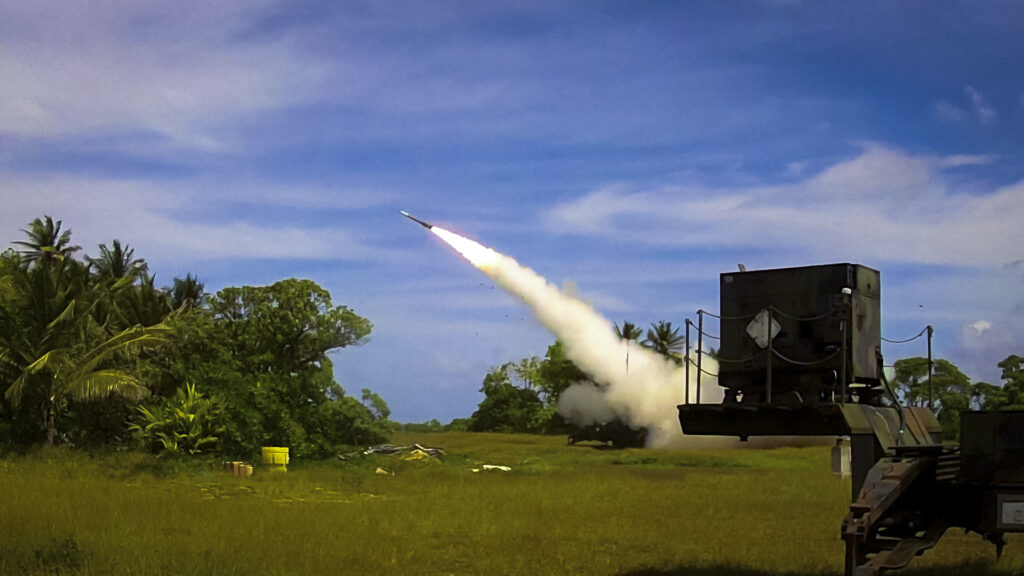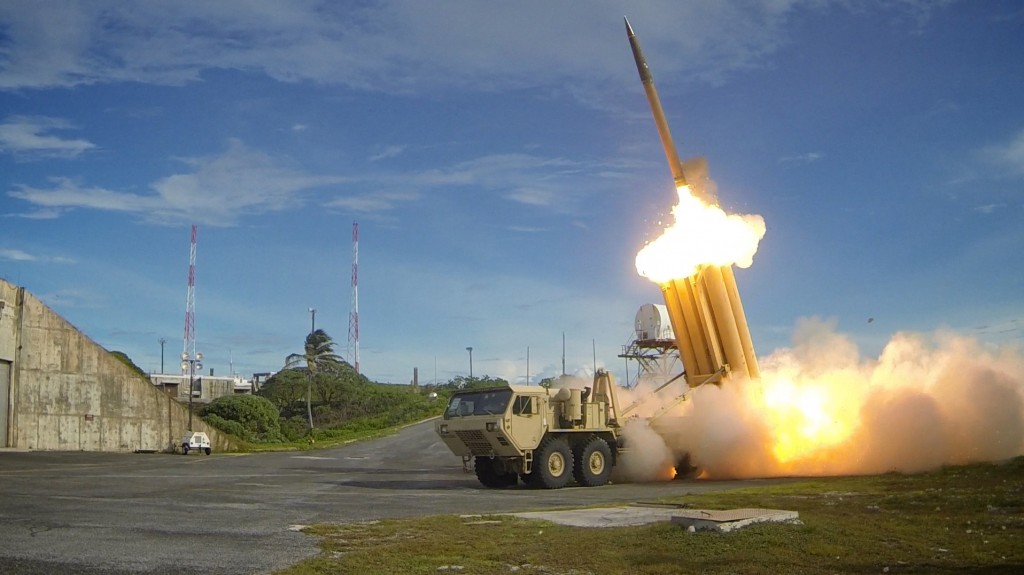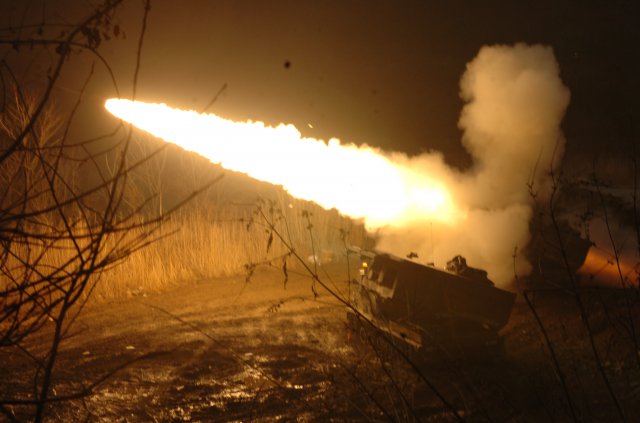
Army Patriot missile launch
ARLINGTON: Hitting a bullet with a bullet is an astounding feat. But now that US missile defenses can do it routinely, we’re realizing it’s not enough.
As technology spreads around the world, more countries are getting larger numbers of more capable missiles. A cash-strapped America can’t afford to shoot down each incoming threat with a specialized, expensive interceptor like the Patriot. That’s forcing the US military both to find new ways to use existing systems and to look beyond traditional interceptors to technologies like lasers, cyber attack, and jamming.

Lt. Gen. David Mann
“We will never have enough interceptors,” said Lt. Gen. David Mann, who heads Army Space and Missile Defense Command. (It’s the Army that handles most missile defense, although the role of the Navy’s Aegis radar and Standard Missile is growing). “[So] we need to add a level of sophistication to the way we look at the threat,” Mann told an Association of the US Army conference here. “It has to be more than just a metal-on-metal application.”
What the Army needs from industry and researchers, the assembled officers and experts made clear, is not so much new technology as new ideas.
“I get a lot of offers to consider tools and technology,” Maj. Gen. John Rossi told me. “I get less on, ‘here’s a concept on how to employ what you have in a different way to gain some advantages.'” Rossi heads the Army Fires Center at Fort Sill, Oklahoma, which oversees training, doctrine, and requirements for both offensive artillery and missile defense. We have to make the most of what we already have, he emphasized, “because when there’s limited resources, you’re not going to get a whole lot more.”

A Hydra-Headed Threat
Unfortunately, the people getting “a whole lot more” right now are the bad guys.
“Regardless of whether we’re talking about unmanned aerial systems, whether we’re talking about aircraft, whether we’re talking about missile systems…there is more of everything,” said Jeffrey Haworth, director of intelligence and security in the missile defense component of US Strategic Command. “There is more of everything at every range, there is more of everything at every capability, there is more of everything at every category of threat.”
And “quality has a quantity all its own,” Haworth reminded the AUSA conference: Even the best missile defenses we have now will run out of interceptors if an enemy shoots enough stuff at them.
But the quality of the threat is getting better, too, as technology spreads around the globe. “We cannot stop tech transfer,” Haworth said flatly. “History has proven it’s impossible. Our very best efforts in the Cold War told us so” — and the spread of new technology has only gotten faster since.
Every ballistic missile fired in anger at Americans since World War II has been a crude Iraqi Scud. What’s more, Saddam Hussein typically lobbed his Scuds at us or Israel just a few at a time, with most of his mobile launchers hiding at any given moment. Modern Chinese tactics, by contrast, call for salvoing scores of missiles at once. And ballistic missiles may not be the only problem.

Brig. Gen. Christopher Spillman
“We’re beginning to see a new threat [tactic] called the ‘complex integrated attack,'” said Brig. Gen. Christopher Spillman, commandant of the air defense school on Fort Sill. Such an attack launches ballistic missiles, cruise missiles, and armed drones at the same target at the same time — accompanied by jamming (electronic warfare) to deceive and disorient the defenders.
“We’ve got some serious gaps that we’re going to need to get after, particularly in cruise missile defense and counter-UAS [unmanned aerial system, i.e. drone],” said Col. Randall McIntire, director of air and missile defense in the operations section of the Army’s Pentagon staff.
A cyber-savvy adversary might even plant viruses in US networks months in advance of any physical attack. Warned Haworth, “We need to think about this 90 to 120 days before hostilities even begin, at a minimum.”

THAAD missile launch.
A Holistic Defense
A “complex integrated attack” requires a complex integrated defense. Future enemies will use jamming and hacking to disrupt our defenses, then launch multiple types of missiles and drones at the weak points they’ve created. So we need to respond by jamming and hacking the systems that direct their attack, then shoot down the missiles that do get through with multiple defensive weapons, from traditional missile defense interceptors to high-energy lasers.

Rear Adm. Jesse Wilson
“We no longer can shoot down everything that the enemy fires at us,” said Rear Adm. Jesse Wilson, the director of the Joint Integrated Air and Missile Defense Organization (JIAMDO). “We need to look left of launch” — that is, stop the enemy from being able to fire at all using tactics such as cyber attacks and electronic warfare.
While the Army’s working hard to revive its electronic warfare branch, the Navy is the most sophisticated service in both technology and concepts for EW. But the whole military has a ways to go on electronic warfare.
“We used to be better at this back in the Cold War era,” Wilson told me. “We were heavy in EW going against the Soviets, and then when the Wall came down, a lot of that atrophied. We need to bring it back.”
Why is electronic warfare so important? Because it can break what the military calls “the kill chain.” The term refers to the entire process from thinking about attacking to destroying the target. The point is you can defeat an attack by breaking any link in the chain, not just by shooting down the missile as it screams towards you.
“If I can disrupt other arts of the adversary’s kill chain, I don’t have to fire an SM-3, I don’t have to fire a Patriot, I don’t have to fire a THAAD,” Wilson said. Given the limits on how many interceptors we can buy, he added, “I don’t have the numbers to do it anyway.”
“The enemy has to do all the things that we do in the kill chain to be effective,” Wilson told me. “They’ve got to find [us], they’ve got to fix, they’ve got to track, target, and engage.” In a modern military, most of those functions depend on electromagnetic transmissions: radar to spot the target, radio to relay its precise coordinates, wireless computer networks to coordinate the operation.
Of course, we need to protect our radars, radios, and networks from their jamming and hacking. That’s not easy — and against a sophisticated foe, we’re going to have to accept some losses.

Brig. Gen. Neil Thurgood
“Do I build a Patriot launcher that is 100 percent infallible to electronic attack? Probably the answer is no; we probably can’t afford it,” said Brig Gen. Neil Thurgood, the Army’s program executive officer for missiles and space systems. Rather than invest in a handful of heavily protected systems, it’s better to seek resilience in a large number of systems with different, complementary capabilities. “It’s pretty easy to electronically kill…an individual ship; it’s hard to electronically kill a fleet,” he said. If the enemy neutralizes our S-band radars for example, so be it: What matters is we can move to X-band (and vice versa).
The electromagnetic battle doesn’t end when the enemy hits the launch button. Once underway, a missile relies on external guidance, its own sensors, or both to home in on the target. Those guidance transmissions can be jammed, the sensors deceived or — with new electromagnetic pulse and microwave weapons — outright fried.
American planes already blind incoming anti-aircraft missiles with low-power lasers. The Navy is now testing a 30-kilowatt laser capable of shooting down slow-flying drones, which it’s deployed experimentally to the Persian Gulf. The Army has a similar 10-kw laser mounted on a truck, the High Energy Laser Mobile Demonstrator (HEL MD).
The HEL has already shot down drones and incoming 60 millimeter mortar rounds in tests. Army Chief of Staff Ray Odierno himself came to visit the prototype earlier this month, Mann recounted.
“How soon can we operationalize this?” Gen. Odierno asked Mann. “Can you take that vehicle and deploy it right now?”
“Well, you know, we can with some risk,” Mann said. “But I think it’s important right now we work expectation management.” We’re about 40 kilowatts and an unknown number of years away from a laser capable of killing cruise missiles.

Army HEL (High Energy Laser) Mobile Demonstrator
Network of Patriots
Right now, Mann says, the Army air and defense community’s “number one priority” is getting what they already have to work together better. The key to that deceptively simple-seeming challenge is a new command-and-control network called the Integrated Battle Command System. Hailed as an “exemplary” program under the Better Buying Power initiative, the Northrop Grumman-built IBCS will face its crucial “Milestone C” review of whether to proceed with production sometime next year and achieve initial operational capability in 2018.
“We need to do a better job of integrating capabilities,” Mann told reporters at the AUSA conference. “In years gone by, we kind of were in stovepipes[:] Patriot here, THAAD here, Aegis over here.. We now recognize that to be good stewards of taxpayer monies, we need to do a better job of integrating the capabilities we have not only across the army, but across the joint force and [allies].”
Currently, missile defense systems are take-it-or-leave-it packages. There’s a Patriot radar and a Patriot control station as well as a Patriot missile launcher, for example, and they’re designed to work together: “You can’t untether them,” said Brig. Gen. Spillman. The idea behind IBCS is to give everything the same standardized connection so everything can talk to everything else. For example, you could use a Patriot radar to aim a THAAD missile or a general-purpose control station to fire a Patriot. (The appalling Army jargon for this is “componentization”).
The Army has also tested connecting IBCS to the Navy’s Cooperative Engagement Capability (CEC) network, albeit in a lab and not yet in a field. The plan is to link IBCS to the Missile Defense Agency’s Command and Control, Battle Management, & Communications system (C2BMC) as well. All these systems may seem like a lot of alphabet soup. But the idea behind connecting them is to get data on each threat from sensor best positioned to see it — regardless of who owns that sensor — and respond with the weapon best suited to defeat it — whether it’s a traditional missile defense interceptor, a laser, or an electronic warfare system.
Ultimately, the Army wants ICBS to include offensive weapons like ATACMS missiles and guided Multiple Launch Rocket Systems (GMLRS). That way, the same sensors that warn defensive systems of an incoming attack can also cue offensive systems to retaliate — or better yet, to destroy the enemy launcher before it even fires. Sometimes the best defense really is a good defense.
“You just cannot afford to continue to try to defend yourself or your friends or allies against things that are being shot at you [indefinitely],” said Barry Pike, civilian deputy to Maj. Gen. Thurgood. At some point, Pike said, “you actually have to make somebody stop.”

Army Multiple Launch Rocket System
Iran says it shot down Israel’s attack. Here’s what air defense systems it might have used.
Tehran has been increasingly public about its air defense capabilities, including showing off models of systems at a recent international defense expo.


























